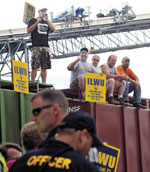
Showdown on West Coast Docks: The Battle of Longview
(November 2011).
click on photo for article
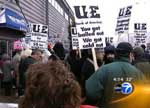
Chicago Plant Occupation Electrifies Labor
(December 2008).
click on photo for article
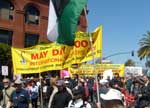
May Day Strike Against the War Shuts
Down
U.S. West Coast Ports
(May 2008)
click on photo for article

December 2013
Fast Food Workers
Need a Whopping Raise,
and a Fighting Union!
Class Struggle Against Poverty Wages
Pressuring Democrats Is a Dead-End
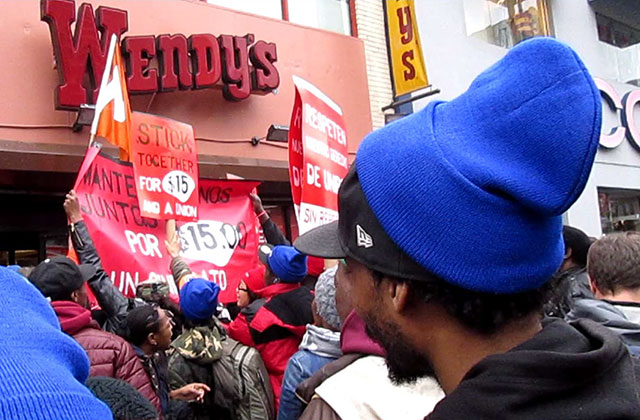
Above: Boistrous demonstration for $15/hour wage outside restaurant on Fulton Street, Brooklyn, December 5. (Internationalist photos)
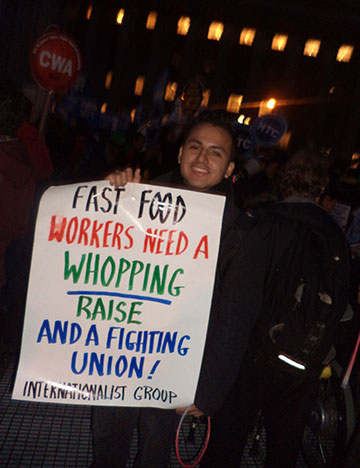
Build a Revolutionary Workers Party!
DECEMBER 5 – Over the last year and a half there have been a number of well-publicized protests at fast-food restaurants like McDonald’s, Burger King and Wendy’s, and at stores of the vast Walmart chain, the largest private employer in the world. Although they have been billed as “strikes,” the number of workers who have actually walked off the job is very small – for obvious reasons, since they face immediate dismissal by their viciously anti-union employers at the least sign of labor militancy. Mostly these have been media events organized by a few unions and foundation-funded NGOs (“non-governmental organizations”). But they have gotten attention and the conditions faced by low-wage workers are so terrible that they could eventually spark something.
If and when that happens, the question will be posed starkly: what next? The vast majority of these protests are actually aimed at influencing the Democratic Party. The rally today in New York City is billed as “New Day New York” and demands “an end to inequality and the tale of two cities.” This is a clear reference to last month’s election of Democrat Bill de Blasio as mayor and echoes his campaign themes. But the idea that putting a liberal Democrat in charge of City Hall instead of Republican billionaire Michael Bloomberg would end, or even put a serious dent in, inequality is a fairy tale. (To be sure, Bloomberg’s arrogance is unmatched: he insisted on finishing his golf game in Bermuda before jetting back to NYC after the Metro-North crash!)
So who is running this “movement” and what is their game
plan? The main force behind the Walmart “strikes” is the
United Food and Commercial Workers (UFCW) union which has
funded the groups OUR Walmart and Making Change at
Walmart. But rather than a serious drive to unionize
Walmart workers, the UFCW’s main strategy has been to get
Democratic-led city councils to keep the big box stores
out of the major cities. As for the fast-food protests,
these are mainly led (and financed) by the Service
Employees International Union (SEIU), which is behind Fast
Food Forward in NYC and “Fight for $15” elsewhere in the
country, as well as various pro-Democratic NGOs. Their
focus is on pressuring Democratic “elected officials.”
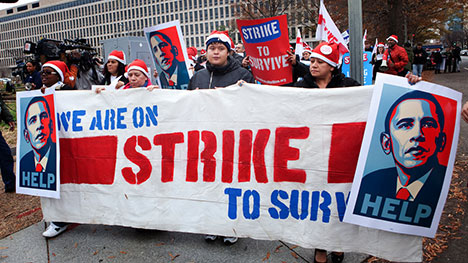 Fast-food organizing campaign led by SEIU
focuses on pressuring Democratic Party. Left:
demonstration near McDonald’s restaurant outside
Smithsonian Museum, Washington, D.C., December 5, calls on
Obama to help. (Photo: NPR)
Fast-food organizing campaign led by SEIU
focuses on pressuring Democratic Party. Left:
demonstration near McDonald’s restaurant outside
Smithsonian Museum, Washington, D.C., December 5, calls on
Obama to help. (Photo: NPR)This is hardly surprising. Of all the unions in the U.S., the SEIU is most notable for its close ties to the Democrats, practically acting as the labor auxiliary of that capitalist party. (1199 SEIU was the main union backing de Blasio before he won the Democratic primary.) And groups like New York Communities for Change (NYCC, formerly ACORN) and Make the Road are essentially fronts for the Democratic Party. But what exactly do they want the Democrats to do? That’s not entirely clear at this point, perhaps even to the SEIU tops led by Mary Kay Henry. It will doubtless include legal challenges to franchise operations, local minimum wage ordinances, promoting “worker centers,” and eventually (they hope) signing up lots of dues-paying members.
That the union bureaucracy is making a serious push is clear. A recent article (“Fight for 15 Confidential,” In These Times, 11 November) by Arun Gupta based on interviews with a number of low-wage organizers and reviewing “hundreds of pages of internal documents from the campaign,” reports that the SEIU poured some $3 million into the coffers of Action Now in Chicago (another former ACORN affiliate), as well as $2.5 million to NYCC in New York and millions more to public relations firms including Purpose, M+R Strategic Services and BerlinRosen for help with “branding,” a social media campaign and communications strategies. If this sounds like some corporate operation, that’s no accident: that’s how SEIU operates.
For now, what the SEIU tops are after is grabbing market share so that they dominate the low-wage organizing field. In the past their typical strategy has been to pressure employers to agree to “neutrality pacts” to let the union sign up members, and then to negotiate contracts with few benefits and (of course) an iron-clad no-strike clause. In the case of fast-food workers, they have preferred to work through NGOs and worker centers rather than unions, arguing (as do various would-be leftists) that this is a way of getting around the spider’s web of anti-labor laws. But once they have a dues base solidified, they will submit to those very laws which the bureaucrats hide behind in order to stave off membership demands for militant action.
It’s a whole bureaucratic operation. Gupta’s article quotes a number of low-wage organizers detailing how “At the shop level we control the messaging, we control the tactics, we decide what we want to organize around, we motivate the strikers…. If it’s been decided at some level that there will be an action on a given day, then it’s going to happen. It’s just a question of going through the motions of getting people to come to the decisions that they want them to.” A call for a national “strike” on August 29 was launched at a mid-August convention in Detroit of 700 workers, organizers and staff where they held a stage-managed vote with little or no prior discussion before the event. Workers democracy it ain’t.
Some of the organizers have become disillusioned with the rigid top-down control, and worry about what the ultimate outcome is to be. This is also echoed by some on the left who have been involved in the organizing but are a bit queasy about the methods. Big surprise: the SEIU are past masters of bureaucratic class collaboration. Whatever the specifics, any organization they build will not be subject to rank-and-file control. But this critique is insufficient. The bottom line is that to wage a genuine and potentially successful struggle against poverty wages, it is necessary not only to have union democracy but also its prerequisites: total independence from the capitalists, the capitalist parties and the capitalist state.
The sorry state of trade unions in the U.S. is not due so much to anti-labor laws as to the unwillingness of union leaders to defy the bosses’ legality. The policy of the labor fakers is class collaboration as opposed to class struggle. A main reason that grocery unions have not been able to organize upscale non-union outfits is that workers in non-unionized stores like Whole Foods and Trader Joe’s make upwards of $2 an hour more than those in unionized supermarkets, where they typically start out at the minimum wage and hardly rise from there. Meanwhile, the unions (RWDSU/UFCW) backed the 2012 buyout of A&P even as it closed stores, because the new owner, billionaire private equity investor Ron Burkle, is a big Democratic Party donor.
At a demonstration outside a Wendy’s restaurant on Fulton Street in Brooklyn this morning, protesters chanted “we are the mighty, mighty workers” and “union power.” But to mobilize that power, and to wage a serious fight against poverty wages, it is necessary to drive the pro-capitalist labor bureaucrats out of the unions. And while the SEIU, UFCW and NGO officials treat the few low-wage workers they have attracted as props or movie extras to be bussed in for crowd scenes in their media productions, unionizing fast-food workers will take real strike action that requires developing worker cadres with the skills, consciousness and political program to wage a bitter fight against a powerful class enemy.
As the momentum has built up in the fast-food campaign, several reformist left groups have sought to get in on the action, some signing up as organizers. Experiencing the heavy hand of the SEIU/NGO operation has led to some public controversy, notably among supporters of the International Socialist Organization, with some agonizing over the effect on the workers while others side with the bureaucrats to the point of opposing a rank-and-file caucus (see “Assessing the Fight for 15,” Socialist Worker, 9 September). But mild critics and bureaucratic apologists alike will find that once the media operation is over they will be discarded “like squeezed lemons,” with only the hard-core Democratic Party loyalists making it onto the payroll.1
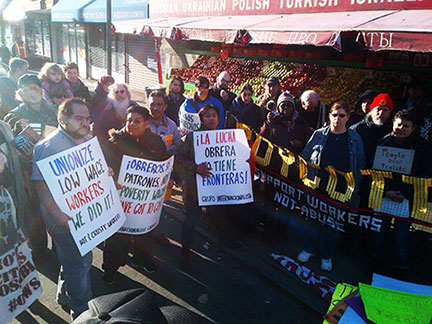 After winning their own struggle, Hot and
Crusty workers join picket at anti-union market in
Brooklyn, January 2013. (Photo: goldenfarmjustice)
After winning their own struggle, Hot and
Crusty workers join picket at anti-union market in
Brooklyn, January 2013. (Photo: goldenfarmjustice)An example of a successful campaign to unionize low-wage workers was the struggle at the Hot and Crusty bakery restaurant on Manhattan’s Upper East Side last year, in which the Internationalist Group and CUNY Internationalist Clubs actively participated. Two months of picketing resulted in a contract with union control of hiring, something almost unheard of in recent years although it was key to building strong unions in formerly low-wage industries like dock workers and the construction trades. Key to victory at Hot and Crusty, even on a small scale, was determination to hold out on the picket line for weeks on end, not relying on the capitalist state or politicians, and bringing out broad labor support. (See “Hot and Crusty Workers Win With Groundbreaking Contract,” The Internationalist, December 2012 and other articles at www.internationalist.org.)
Giant corporations like Walmart, McDonald’s and the other wage-gougers are not going to become model “corporate citizens” just because a well-heeled labor outfit launches a flashy media campaign. Their entire profits and the whole capitalist system is based on merciless exploitation of working people. Who’s going to pay for the luxury $35 million luxury Bombardier corporate jet that McDonald’s just bought if not the wage slaves sweating for the minimum wage in its kitchens? The present campaign aims at installing a bureaucracy to keep “labor peace” for the bosses, and that will be so whether the bureaucrats are former Occupy Wall Streeters or seasoned SEIU operatives.
At this morning’s demo outside Wendy’s in Brooklyn, workers chanted, “We can’t survive on $7.25,” the national minimum wage which is also the minimum in NYC, one of the most expensive cities in the country. Several protesters, added “We can’t survive on $8.25,” on $9.25, on $10.25, and kept on going. They’re right. No nickel-and-dime, penny-ante increase in the minimum wage will do. The only road to actually breaking the cycle of poverty, racism and endless war that is inherent in capitalism is for those organizing low-wage workers to put forward a program of militant class struggle, breaking with the Democrats to form a revolutionary workers party.
Such a program must not limit itself to wages but must take up all the forms of oppression we face. Women are a majority of low-wage and part-time workers, and a large number are single moms. A real fight to defend them must include demands for free, 24-hour daycare. Also, most employees of fast food restaurants are African American, Latino and Asian workers who also face racist repression, like the notorious “stop and frisk” practices of the NYPD. Instead of talking of “reforming” this racist profiling, as mayor-elect de Blasio does, class-struggle militants call for workers mobilization to put an end to “stop and frisk” once and for all.
For the large number of undocumented workers trapped in low-wage jobs, a key demand is for full citizenship rights for all immigrants: everyone should have the same rights. And as U.S. imperialism under commander in chief Obama continues its wars around the world, working-class internationalists fight to defeat the war on working people, “at home” and abroad, through international socialist revolution. A tall order, but it’s the only road. ■
- 1. This echoed a dispute last year when the ISO leaders repudiated their own members when the West Coast International Longshore and Warehouse Union misleaders turned on the Occupy movement and ILWU militants, breaking up a rally supporting the fight against union-busting at EGT in Longview, Washington (see “‘Socialist’ Excuses for Disruption of Labor Solidarity Forum,” The Internationalist, February 2012).
Academic BS Against a Minimum Wage Hike
Amid all the media hype over an increase to the minimum wage – which will predictably produce at most a minimal increase, if that – we are treated to a learned debate among economists over whether a raise will help low-wage workers at all. This flim-flam is nothing but a cynical justification of the stratospheric profits extracted by the multi-billion corporations who live off the superexploitation of their impoverished employees.
In response to Obama’s tepid call for a slight increase in the minimum wage, the Washington Post (5 December) “Fact Checker” cited a “survey of more than 100 studies” by economists David Neumark and William Wascher that supposedly showed that “raising the minimum wage … has adverse consequences for the employment opportunities of low-skilled workers.” All that shows is that the authors, who are long-time opponents of any minimum wage, can cherry-pick studies which they deem “credible” (more than one-fourth of which were their own “research”).
As for the claim that low-wage workers have low skills, this, too, is an invention. Ditto for the assertion, by McDonald’s and other poverty-wage profiteers, that they provide “entry-level jobs.” The image of minimum-wage workers as teenagers flipping hamburgers in after-school jobs is wildly inaccurate. The average age of low-wage workers is 35, and if in 1979 40 percent had less than high school education, today 43 percent have at least some college (Center for Economic and Policy Research, April 2012).
Various schemes are floated to deal with the problem without raising pay above the $8.80 per hour(the national median for fast-food workers). The New York Times (5 December) has a whole debate on “Making Low Wages Livable.” Increase the earned tax credit proposes Democrat Clinton’s former Secretary of Labor Robert Reich. Subsidize low-wage employers, suggests another – for the likes of McDonald’s and Walmart, who already enjoy huge government subsidies in the form of food stamps, tax credits and Medicaid for their impoverished workers?!
The common thread, among Democrats and Republicans, liberals and conservatives alike, is that low wages are here to stay and better-paid jobs with health care and retirement benefits are history. They all share the watchword of Britain’s vicious union-basher Margaret Thatcher and her Labour Party successor Tony Blair that “there is no alternative” (TINA) to viciously exploitative, globalized capitalism. What is true is that the social-democratic “welfare state” is gone for good, and “neo-liberalism” is not just a policy but a key pillar of capitalism today.
But, of course, there is an alternative: get rid of capitalism altogether, along with its mass poverty, boom-bust cycle, endless wars and social scourges including oppression of women and rampant racism. That, of course, will take some doing.
As for the argument about whether attempts to raise their wages will have any beneficial effect for workers, this was settled a century and a half ago by none other than Karl Marx. In a presentation he made to the General Council of the International Workingmen’s Association (the First International) in June 1865, later published as a pamphlet Value, Price and Profit, the founder of modern communism replied to arguments by one John Weston, a member of the council who echoed the capitalists in opposing workers fighting for increased wages.
Marx laid out in detail how the capitalists are constantly trying to reduce wages to their physical minimum, while workers press in the opposite direction, the result depending on their relative power. If today the share of national income going to wages has fallen dramatically while the portion going to profits has risen sharply, it is above all due to the failure of the trade-union movement to use workers’ power effectively, precisely because the leadership is beholden to the capitalist system, and to its political parties, notably the Democrats.
Marx summed up his argument:
“Firstly. A general rise in the rate of wages would result in a fall of the general rate of profit, but, broadly speaking, not affect the prices of commodities.
“Secondly. The general tendency of capitalist production is not to raise, but to sink the average standard of wages.
“Thirdly. Trades Unions work well as centers of resistance against the encroachments of capital. They fail partially from an injudicious use of their power. They fail generally from limiting themselves to a guerilla war against the effects of the existing system, instead of simultaneously trying to change it, instead of using their organized forces as a lever for the final emancipation of the working class that is to say the ultimate abolition of the wages system.”
If many and possibly most economists argue against increasing the minimum wage, that only shows that they are ideological defenders of the interests of capital. Adapting the old joke about lawyers, one might ask: “What do you call 500 capitalist economists chained together at the bottom of the ocean?” Answer: a good start. As for the cockroach capitalists who under capitalism can only stay afloat by drowning the workers in poverty, they should be driven out of business by militant labor action. In the end, workers revolution will put them out of their misery, while dispatching the Fortune 500 to kingdom come. ■